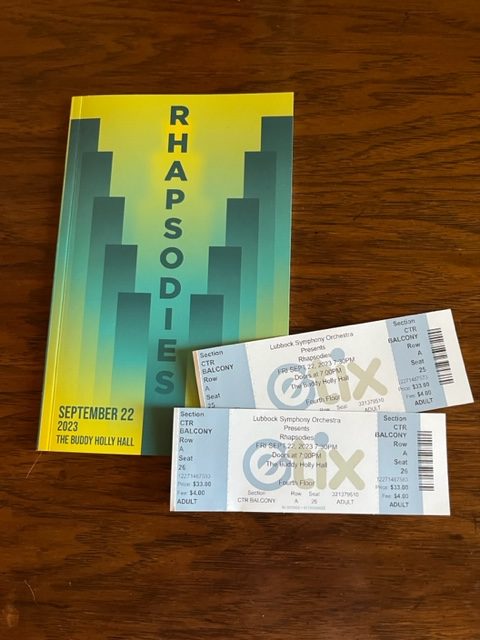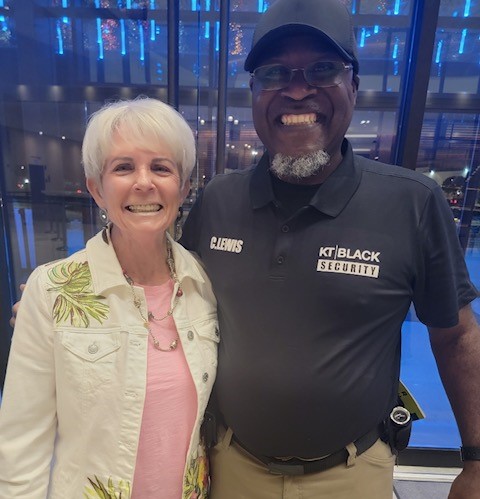Sheila and I attended the Rhapsodies concert at the Buddy Holly Hall Friday night, and it was a fun experience. And I got to hear my favorite Gershwin selection, “Rhapsody in Blue.”
The concert included three selections, Peter Boyler’s “Rhapsody in Red, White, and Blue,” George Gershwin’s immortal “Rhapsody in Blue,” and Beethoven’s well-known “Symphony No. 5,” which pairs well with the first two rhapsodies.
Next year will be the 100th anniversary of “Rhapsody in Blue,” and pianist Jeffrey Biegel wanted to find a way to commemorate this iconic masterpiece of distinctively American semi-classical music. Composer Peter Boyer was eventually commissioned to work with Biegel to write a piece that would compliment and celebrate Gershwin’s work. The complete work was ready this year, 2023, and the goal is to have the finished work titled “Rhapsody in Red, White, and Blue” played in all fifty states as we move into 2024, and they are nearly there.
Gershwin wrote “Rhapsody n Blue” for bandleader Paul Whiteman; the story of how it came to be has a history that I don’t need to go into here, but the finished piece became a favorite that has endured through the years and never grows old. It was first performed in Carnegie Hall in 1924 and was introduced to me by my mother, to whom I will be eternally grateful for doing so.
If you are old enough to remember, you might have heard the beautiful melody movement near the end of the piece as the background music for United Airlines TV ads back in the day. Sadly, ads don’t have that much class anymore.
But I digress. We made our way to the balcony seats, right in the middle of front row A, and experienced a spell of loss of equilibrium due to the height and steepness of the seats! It was hard to focus on the depths of the rows of seats. It was a strange feeling and hard to describe, but I held onto the handrail and stood there for a moment to get my sense of balance back. This picture doesn’t give that same funny feeling we had looking across and down into the lower seats.
Photo courtesy of Sheila Stevenson
Photo courtesy of Sheila Stevenson
We were right smack in the middle of the row and sat down next to a young man from Mexico City, Pedro Tudon Saenz, who is a student studying in the School of Music at Texas Tech. We asked him what brought him to Tech, and he smiled and said it was to study under a professor, a conductor whose work he admires who is also from Mexico City, I believe. I failed to get his name since I didn’t bother to take a notebook for notes, not realizing I would be wanting to write about the night. He is working on his master’s degree and will go on to earn his doctorate in music and become a conductor himself. Bless his heart! I peppered him with music-related questions during the intermission and after the performance, and he patiently answered them for me. One question I asked before the music started was what is a rhapsody by definition, and he said it was like a miscellaneous collection of musical movements or melodies in the same piece of music.That definitely fits “Rhapsody in Blue.”
Photo courtesy of Shelia Stevenson
The concert opened with full orchestra conducted by David Cho and pianist Jeffrey Biegel performing “Rhapsody in Red, White, and Blue.” It was lovely and well-received by the audience. It had its moments that resonated with me, but i will admit, none of the movements have stuck with me to hum and replay in my mind now.
I suspect that is because, no matter how melodic and beautiful it was, nothing stays with me like Gershwin’s masterpiece, which was next, also with Conductor Cho and pianist Bieget. Beautiful music and touches of melodies that float in and out of songs, notes that blend into haunting harmonies, when those notes are hit, they put my heart in my throat and bring forth tears, despite my best efforts not to let that happen. So, I quit trying and just let the music lift me to a place I suspect others are not feeling right then. And that is what happens with “Rhapsody in Blue” and always does, every time I hear it. By the time they reached the exhilarating conclusion of the music, I was a basket case. I make no apologies for it.
The orchestra and conductor took a brief intermission before performing “Beethoven’s Symphony No. 5,” which I had told our new friend Pedro I didn’t think I was familiar with. He smiled and said yes, I would recognize it immediately when they begin playing. He was right, of course, as I knew right away what is was with the four opening notes: da da da DAH! The printed page can’t give you the sound, but think about it a minute and it will sink in. You’re familiar with it, too, I bet! I enjoyed that piece as well.
We took this picture at the end of the concert, a bit concerned that we might get in trouble taking a picture while the orchestra members were on stage about to play!
Photo courtesy of Sheila Stevenson
Afterward, we were in no hurry to wait in lines of traffic in the parking lot, and that’s when I asked Pedro many of my questions, the first one being that I noticed the saxophones, nearly all of the percussion section, and the piano left the stage for the Beethoven number. He said the saxophone had not been invented when Beethoven was alive, therefore no parts for that instrument were written for the piece. Other instruments may have also left the stage for the same reason, and I was just not aware of them being gone; we were far away from the stage, after all! He said most all the percussion sounds during Beethoven’s time were associated with war and not used in classical pieces; only the timpani drums were used for this. We talked of other musical terms, and it was a pleasure meeting him.
As we left, a trip to the restroom was in order, and as we made our way to the far side of the building to find one, we passed a man who looked official in his black security company t-shirt who confirmed we were headed in the right direction. As I passed, he said something, and I turned around to hear him, he ask again, questioningly, “Mrs. Liles?”
And my goodness, then I recognized former student Clarence Lewis! I was so glad he said something because I was not paying attention to who he might be. He works building security at the hall on a part-time basis, and I was happy that we accidently ran into each other. I am pretty sure this was the first time I had seen him in the flesh since high school. I see him on Facebook from time to time, so it was a fun encounter.
Photo courtesy of Sheila Stevenson
We had to drive home in the dark, of course, but we enjoyed the evening and were glad we bothered to make the trip. After I got home, I dug out my CD of Gershwin’s enduring semi-classical favorite done by Arthur Fieldler and the Boston Pops and look forward to reliving the night when I need to rekindle my heart.
And those of you who think you are not familiar with Gershwin’s music or Beethoven’s da da da DAH, make it a point to listen to it somewhere. You will be glad you did.
Because everyone can always use a little bit of a rhapsody in blue.
Thanks, Sheila, for taking pictures since I left my phone in the car, thanks to Pedro for being a new friend, and thanks, Clarence, for not letting me go by without a hello!






Nice story!
Thanks! It was a nice concert and evening.
Thanks to you, Alice! I had the must fun talking to you guys!
I learned a lot from you, Pedro! It was a fun night.